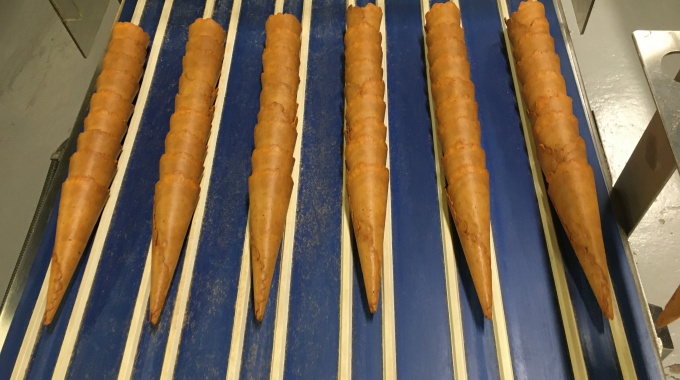For gelato makers, few things matter more than ensuring customers experience your product exactly as you intended: smooth, creamy, and indulgent from the very first scoop. While gelato stored at the correct temperature won’t technically “go off,” quality can begin to decline almost immediately after freezing. Texture changes, crystallisation, and flavour loss can all shorten the perceived shelf-life of your product, and with it, customer satisfaction.
Understanding how to extend shelf life is not about simply keeping gelato frozen; it is about protecting the structure, recipe, and integrity of what you’ve created. By combining thoughtful recipe design, science-led processing, and strict storage rules, you can slow the changes that affect quality, thus improving customer experience and reducing waste.
Why shelf-life matters
Unlike some foods that spoil due to bacteria or mould, frozen desserts remain microbiologically safe when stored at the right temperature. The challenge for gelato instead lies in texture and taste. Even if it is technically ‘safe’ to eat, a product with large ice crystals or a sandy mouthfeel will leave customers disappointed and unlikely to return.
There are two common culprits to look out for:
> Ice crystallisation: Free water in the mix can form larger crystals over time, particularly if the product undergoes temperature fluctuations. This makes the gelato feel rough and cold on the tongue rather than creamy.
> Lactose crystallisation: When milk solids are not carefully balanced, lactose can crystallise into sharp particles that feel sandy and unpleasant.
Best before dates matter because they ensure customers eat your gelato while it still delivers the smoothness and flavour that you worked so hard to perfect.
Building a structure that lasts
The way gelato is made has a huge impact on how well it holds up during storage. Good structure at the start means longer-lasting quality. Here are our top processing tips:
1. Hot process pasteurisation for emulsification
Heating the base mix is the foundation of shelf life. When you pasteurise, whether making large industrial batches or smaller artisan mixes, heat helps proteins unfold and emulsify, creating a strong fat–protein network. This stabilises the air cells and keeps fat and water evenly dispersed, reducing the chance of large ice crystals forming.
Premium stabilisers, such as locust bean gum, only reach their full potential under hot-process conditions. By giving them the right environment to hydrate and work effectively, you reinforce the texture and extend the product’s life in the freezer.
2. Homogenisation for finer structure and durability
For larger producers, homogenisation is another tool for improving durability. Breaking down fat globules increases their surface area, allowing proteins and emulsifiers to form a stronger, more stable fat network. This slows down meltdown during serving, makes the product more resistant to the effects of heat shock, and physically hinders ice crystallisation.
The result is a finer, more uniform structure that stands up better to the stresses of storage and transport.
Creating a recipe for success
Even with the best processes in place, if your recipe isn’t up to scratch, your gelato may not stand the test of time. Every ingredient influences structure, water activity, and how the product responds to freezing. Here’s some things to keep in mind:
1. Using glucose and maltodextrin
Both glucose and maltodextrin act like sponges, binding free water that would otherwise form ice crystals. By reducing the amount of unbound water, they create a more viscous environment that slows molecular movement. This means that ice crystals grow more slowly, keeping the texture smoother for longer.
2. Getting milk solids right
Lactose crystallisation is one of the most common problems in gelato. Balancing milk solids ensures that lactose stays dissolved, avoiding that unpleasant sandy texture. The result is a cleaner mouthfeel and better perceived freshness, even weeks after production.
3. Balancing sugars and total solids
The mix of sugars you use doesn’t just affect sweetness; it governs freezing point and water activity too. Combining sugars carefully allows you to manage hardness and scoop-ability while supporting structure. Likewise, the right level of total solids, from both dairy and non-dairy sources, strengthens the body of the gelato and reduces the amount of free water available to crystallise.
The reward for this careful balance is a gelato that maintains its intended texture and flavour for longer.
Protecting the ‘cold chain’
Even the most carefully designed recipe and process can only go so far if storage conditions for your gelato aren’t right. Protecting the cold chain, from production through transport and into the cabinet, is essential for shelf life. Check out our top tips below:
1. Hardening and holding
The faster you freeze your gelato after extraction, the better. Rapid blast freezing locks in the small crystals formed during churning and prevents them from growing. Hardening to the core of the product is key; surface freezing alone won’t protect the texture inside the tub, this is why blast-freezing is essential.
Once hardened, keeping gelato at consistently low temperatures slows down further changes.
2. Preventing heat shock
One of the biggest threats to gelato quality is heat shock, where small ice crystals melt and refreeze into larger ones during temperature fluctuations. These changes are irreversible and quickly noticed by customers. Holding gelato at -18°C or colder is essential to minimise this risk.
3. Cold chain discipline
From factory to cabinet, every stage matters. Using insulated logistics, minimising door-open times, and maintaining stable airflow in storage reduces thermal swings. Packaging also plays a role in buffering products against sudden temperature changes. Finally, good stock rotation ensures customers always experience gelato at its best.
Delivering an excellent product
Extending the shelf life of gelato is not about a single step; it is the combination of process, recipe, and storage working together. By creating a stable structure during production, designing recipes that minimise free water and crystallisation, and protecting the product throughout the cold chain, you can deliver consistently smooth, creamy gelato that keeps customers happy long after production day.
The payoff is clear: fewer quality-related losses, better customer loyalty, and more confidence in your product.
Every gelato maker faces unique challenges depending on their recipes, equipment, and distribution setup. That’s why the Antonelli technical team is here to support you. Whether you want advice on recipe formulation, help refining your process, or guidance on cold chain management, we can work with you to help you deliver a truly excellent (and delicious!) product.
Get in touch today to discuss your needs.



